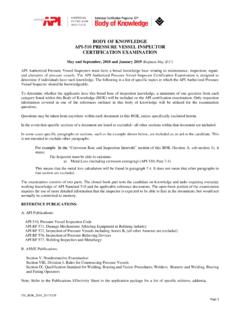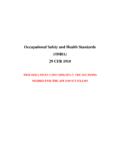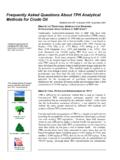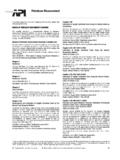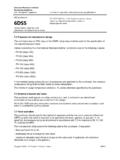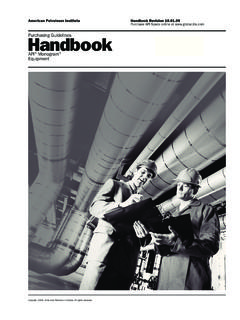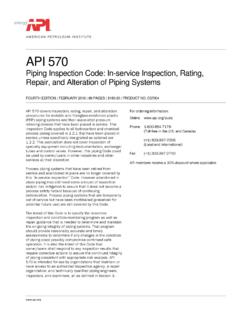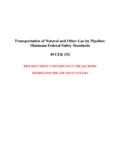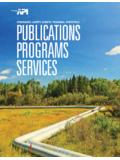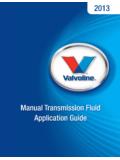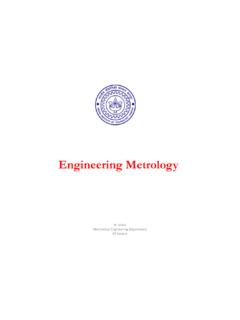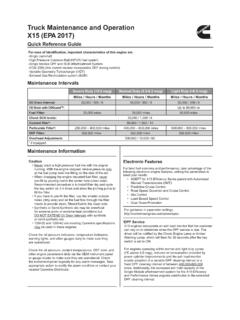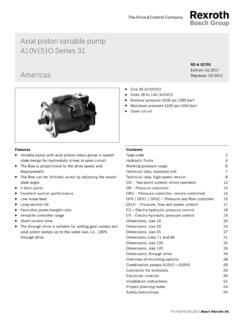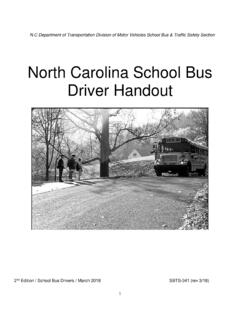Transcription of Eighth Edition April 2013 - American Petroleum Institute
1 Lubricant Service Designations for Automotive Manual Transmissions, Manual Transaxles, and Axles API 1560 Eighth Edition , April 2013 Lubricant Service Designations for Automotive Manual Transmissions, Manual Transaxles, and Axles Downstream Segment API 1560 Eighth Edition , April 2013 Special Notes API publications necessarily address problems of a general nature. With respect to particular circumstances, local, state, and federal laws and regulations should be reviewed. Neither API nor any of API's employees, subcontractors, consultants, committees, or other assignees make any warranty or representation, either express or implied, with respect to the accuracy, completeness, or usefulness of the information contained herein, or assume any liability or responsibility for any use, or the results of such use, of any information or process disclosed in this publication.
2 Neither API nor any of API's employees, subcontractors, consultants, or other assignees represent that use of this publication would not infringe upon privately owned rights. API publications may be used by anyone desiring to do so. Every effort has been made by the Institute to assure the accuracy and reliability of the data contained in them; however, the Institute makes no representation, warranty, or guarantee in connection with this publication and hereby expressly disclaims any liability or responsibility for loss or damage resulting from its use or for the violation of any authorities having jurisdiction with which this publication may conflict. API publications are published to facilitate the broad availability of proven, sound engineering and operating practices. These publications are not intended to obviate the need for applying sound engineering judgment regarding when and where these publications should be utilized.
3 The formulation and publication of API publications is not intended in any way to inhibit anyone from using any other practices. Any manufacturer marking equipment or materials in conformance with the marking requirements of an API standard is solely responsible for complying with all the applicable requirements of that standard. API does not represent, warrant, or guarantee that such products do in fact conform to the applicable API standard. All rights reserved. No part of this work may be reproduced, stored in a retrieval system, or transmitted by any means, electronic, mechanical, photocopying, recording, or otherwise, without prior written permission from the publisher. Contact the Publisher, API Publishing Services, 1220 L Street, , Washington, 20005, USA. Copyright 2013 American Petroleum Institute Foreword This publication describes API automotive gear lubricant service designations.
4 It is designed to assist manufacturers and users of automotive equipment in the selection of transmission, transaxle, and axle lubricants based on gear design and operating conditions. Where special performance requirements apply, the descriptions in the publication conform to the automotive lubricants test language developed by ASTM International. API standards are published as an aid to procurement of standardized equipment and materials. These standards are not intended to inhibit purchasers or producers from purchasing or producing products made to specifications other than those of API. API publications may be used by anyone desiring to do so. Every effort has been made by the Institute to assure the accuracy and reliability of the data contained in them; however, the Institute makes no representation, warranty, or guarantee in connection with this publication and hereby expressly disclaims any liability or responsibility for loss or damage resulting from its use or for the violation of any federal, state, or municipal regulation with which this publication may conflict.
5 Suggested revisions are invited and should be submitted to the Standardization Director, American Petroleum Institute , 1220 L Street, , Washington, 20005, USA. Contents 1 Introduction .. 1 2 Normative References .. 1 3 Service Designations in Current Use .. 1 API GL-4 .. 1 API GL-5 .. 2 API MT-1 .. 2 4 Service Designations not in Current Use .. 2 API GL-1 .. 2 API GL-2 .. 2 API GL-3 .. 3 API GL-6 .. 3 Lubricant Service Designations for Automotive Manual Transmissions, Manual Transaxles, and Axles 1 Introduction This document was prepared by the Lubricants Group of the American Petroleum Institute to assist manufacturers and users of automotive equipment in the selection of transmission, transaxle, and axle lubricants for the operating conditions described. In some axles, some transmissions, and some transaxles, gears of different designs are available for a variety of service conditions.
6 Selecting a lubricant for specific applications involves careful consideration of the operating conditions and the chemical and physical characteristics of the lubricant. The American Petroleum Institute has released lubricant service designations for automotive manual transmissions, transaxles, and axles. Each designation refers to the performance required of a gear lubricant for a specific type of automotive service. These designations also recognize the possibility that lubricants may be developed for more than one service classification and may be so designated. In developing the language for the service classifications, the Lubricants Group recognized a need to supplement the descriptions for certain gear lubricants, particularly those for hypoid gears, by referring to a series of tests that would serve to provide more detailed information on the performance requirements of such lubricants.
7 These series of tests were developed by Section of Subcommittee on Automotive Lubricants of ASTM International Committee D02, and reference is made to these test procedures in the API service designations described below. Due to changes in manufacturers' recommended practices or due to the unavailability of testing hardware, the Service Designations API GL-1, GL-2, GL-3, and GL-6 are not in current use. The designations listed in Section 3 replace all previous API gear lubricant designations. Automotive gear lubricants are identified by viscosity grade in addition to performance level. SAE J306 defines the requirements for viscosity grade classification. This standard also defines requirements for shear stability and for proper labeling and usage of SAE viscosity number designations. Note: Automatic or semiautomatic transmissions, fluid couplings, torque converters, and tractor hydraulic systems usually require special lubricants.
8 Consult the manufacturer or lubricant supplier for the proper lubricant. 2 Normative References The following referenced documents are indispensible for the application of this document. For dated references, only the Edition cited applies. For undated references, the latest Edition of the referenced document (including any amendments) applies. ASTM D5760 Standard Specification for Performance of Manual Transmission Gear Lubricants ASTM D7450 Standard Specification for Performance of Rear Axle Gear Lubricants Intended for API CategoryGL-5 Service SAE J306 Surface Vehicle Standard Automotive Gear Lubricant Viscosity Classification SAE J2360 Surface Vehicle Standard Lubricating Oil, Gear Multipurpose (Metric) Military Use 3 Service Designations in Current Use API GL-4 The designation API GL-4 denotes lubricants intended for axles with spiral bevel gears operating under moderate to severe conditions of speed and load, or axles with hypoid gears operating under moderate conditions of speed and load.
9 Axles equipped with limited-slip differentials have additional frictional requirements that are normally defined by the axle manufacturer. 2 API 1560 API GL-4 oils may be used in selected manual transmission and transaxle applications where API MT-1 lubricants are unsuitable. In all cases, the equipment manufacturer's specific lubricant quality recommendations should be followed. Although this service designation is still used commercially to describe lubricants, test equipment for performance verification is not currently available. Lubricant end users are advised to request appropriate supporting documentation on previously tested lubricants from their suppliers.
10 API GL-5 The designation API GL-5 denotes lubricants intended for gears, particularly hypoid gears, in axles operating under various combinations of high-speed/shock load and low-speed/high-torque conditions. The performance specifications for API GL-5 are defined in the most recent version of ASTM D7450. Frictional requirements for axles equipped with limited-slip differentials are normally defined by the axle manufacturer. Another widely recognized performance specification for automotive gear lubricants is SAE J2360. Lubricants approved under SAE J2360 satisfy the requirements of API Category GL-5. SAE J2360 contains performance requirements that exceed those of API Category GL-5. For example, SAE J2360 has requirements for elastomer compatibility and gear cleanliness after oxidation that are not contained in API GL-5.
